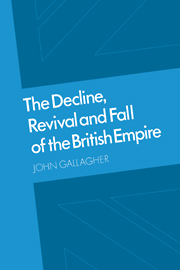The Decline, Revival and Fall of the British Empire
Published online by Cambridge University Press: 28 August 2009
Summary
Edward Gibbon said of the Roman empire that ‘the causes of destruction multiplied with the extent of conquest; and, as soon as time and accident had removed the artificial supports, the stupendous fabric yielded to the pressure of its own weight’. ‘Time and accident’. We might look at the fall of the British empire in a briskly functionalist way, and conclude that it was simply the damage of the Second World War which brought the British empire down. But I shall be arguing first, that the British world system was perilously fragile and had been showing signs of decay long before 1939; secondly, that important sectors of that system were decaying fast after the First World War, when it was moving away from a system of formal rule towards a system of influence; and thirdly, that a result of the Second World War was (temporarily) to reintegrate the system, reversing the trend and turning it back from influence towards empire before the downfall.
Arguments of this sort will commit me to a general position. In examining the breakdown of the British system, I shall be taking for granted that the causes of that breakdown must be sought further back in time, that the collapse had its origins in small sparks eating their way through long historical fuses before the detonations began. But imagery alone will not take us far. ‘Pretty words and they mean nothing’, as the great Lord Salisbury might have said.
- Type
- Chapter
- Information
- The Decline, Revival and Fall of the British EmpireThe Ford Lectures and Other Essays, pp. 73 - 154Publisher: Cambridge University PressPrint publication year: 1982
- 9
- Cited by



